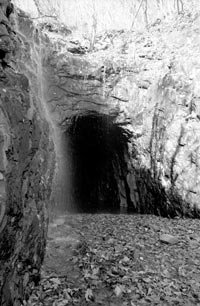Grants galore: But will Afton tunnel re-open?
Chug, chug, chug. Puff, puff, puff. Like the beginning of The Little Engine That Could, the proposed "rail to trail" re-opening of Blue Ridge Tunnel [subject of the Hook's November 21, 2002 cover story] has had similar fits and starts and rumbles. Hidden beneath Afton Mountain, the 19th century engineering marvel that literally put its engineer on the map still awaits its possible future as a walking, biking, horseback path.
"It's time," exclaims Suzanne Gandy-Akers of The Whitesell Group, the Roanoke landscape architecture and planning firm instrumental in leading the effort to reopen the historic monument.
Four-fifths of a mile long– 4,281 feet– the tunnel was by far the longest railroad tunnel in the world when it opened on Christmas Day in 1856. So accurately did engineer Claudius Crozet pen his calculations that only a half inch separated the borings when they met under the middle of Afton Mountain. Crozet was rewarded by seeing his name affixed to a statewide engineering award and a nifty little town.
The process of turning this former railroad wonder over to hikers, bikers, and riders officially began in 2002 with a TEA-21 application requesting a federal grant of $200,000.
Things began gathering steam when that application surprisingly resulted in $300,000 under TEA-21's "enhancement" program that funds projects that enhance alternate modes of transportation. The next year the tunnel netted $325,000 more.
Only "Jamestown 2007" has been awarded more TEA-21 enhancement money. Both have also been designated State Projects, enabling them to tap additional sources of funding. They'll need it.
The Whitesell Group's estimated cost of turning the tunnel into a viable destination point now hovers around $1.8 million. [The print version of this story erroneously reported that this estimate changed since the 2002 proposal, but it has not changed. The erroneous assertion has been removed in this online version of the story.]
In 2003, CSX, which owns the tunnel and the former rail bed, hired Sandy Grice, a Norfolk-based real estate appraiser who specializes in unique properties, to take a look. The narrow 22.63-acre property– roughly 100 feet wide and stretching nearly two miles from Route 250 on the western side of the mountain to Route 6 on the east– is worth $1.5 million, Grice found.
To create the required local "matching funds" for TEA-21 grants, CSX plans to give the land to Nelson County, which will then serve as sole steward of the tunnel even though portions of the land run through Albemarle and Augusta counties.
Nelson will be solely responsible for all costs including but not limited to liability insurance, lighting, security, and whatever else might crop up. Gandy-Akers puts the cost of maintenance at around $2,500 per mile per year or $5,000.
But Bruce Tyler, an attorney whose office and land abut the tunnel property in the village of Afton, scoffs at that sum. He thinks it will cost more like $250,000. That, however, is the just the latest in Tyler's long list of grievances about the project.
"We're getting boondoggled," says Tyler, whose biggest beef lies with the fact that although Nelson will foot the bill, Tyler believes Augusta may end up reaping the greatest benefits. The western entrance to the tunnel is a brick beauty, and Tyler figures that from there sightseers will head off to nearby Waynesboro for sustenance and shopping.
The eastern side looks like a giant dark maw carved into the rough mountain granite. Tyler has been assured that from this portal a double switchback trail (donated by another landowner) will lead trail-users back to the scenic overlook on Route 250 instead of through his property.
Tyler had been living in the old Afton stationmaster's house next to the original tracks a stone's throw from the current live rails until January 27, when the house burned to the ground. He says it was a chimney fire and plans to rebuild.
Despite Tyler's objections and his mantra "No one in Afton wants it," plans are at full throttle. The Whitesell Group envisions the finished project as including a visitors' center and a museum. [The print version of this story alleged that the Whitesell Group is consructing a model of the proposal, but it is not. This error has been corrected in this online version of the story.]
But "It's not going to turn into Las Vegas," says Gandy-Akers.
The Whitesell Group hopes that a public forum scheduled for late spring will serve to calm fears and persuade people of the benefits of the project.
"It's a win-win situation for everybody," says Gandy-Akers, while Tyler continues to hope the project gets sidetracked.


The eastern opening of Mr. Crozet's tunnel.
CHESAPEAKE & OHIO HISTORICAL SOCIETY
#